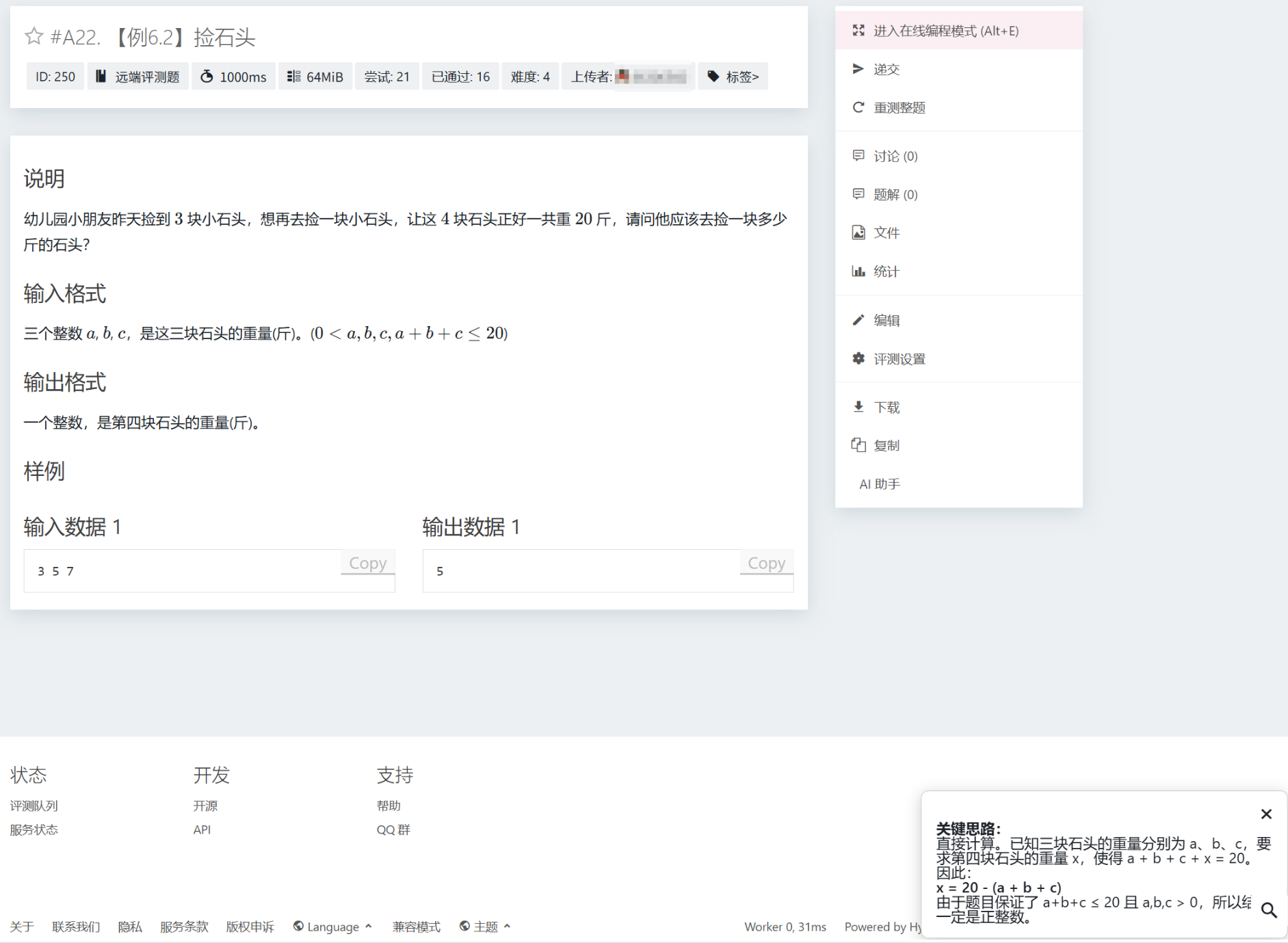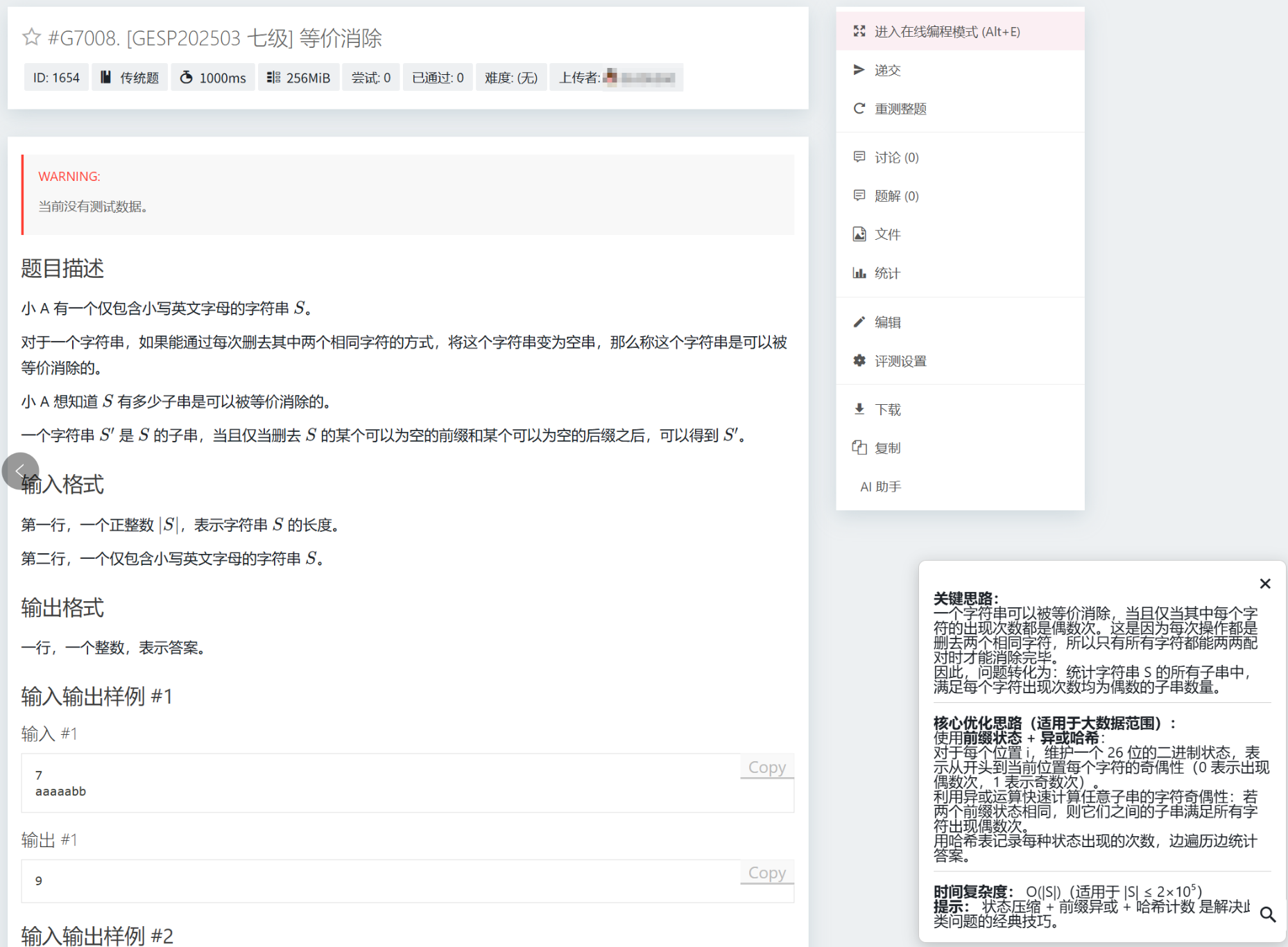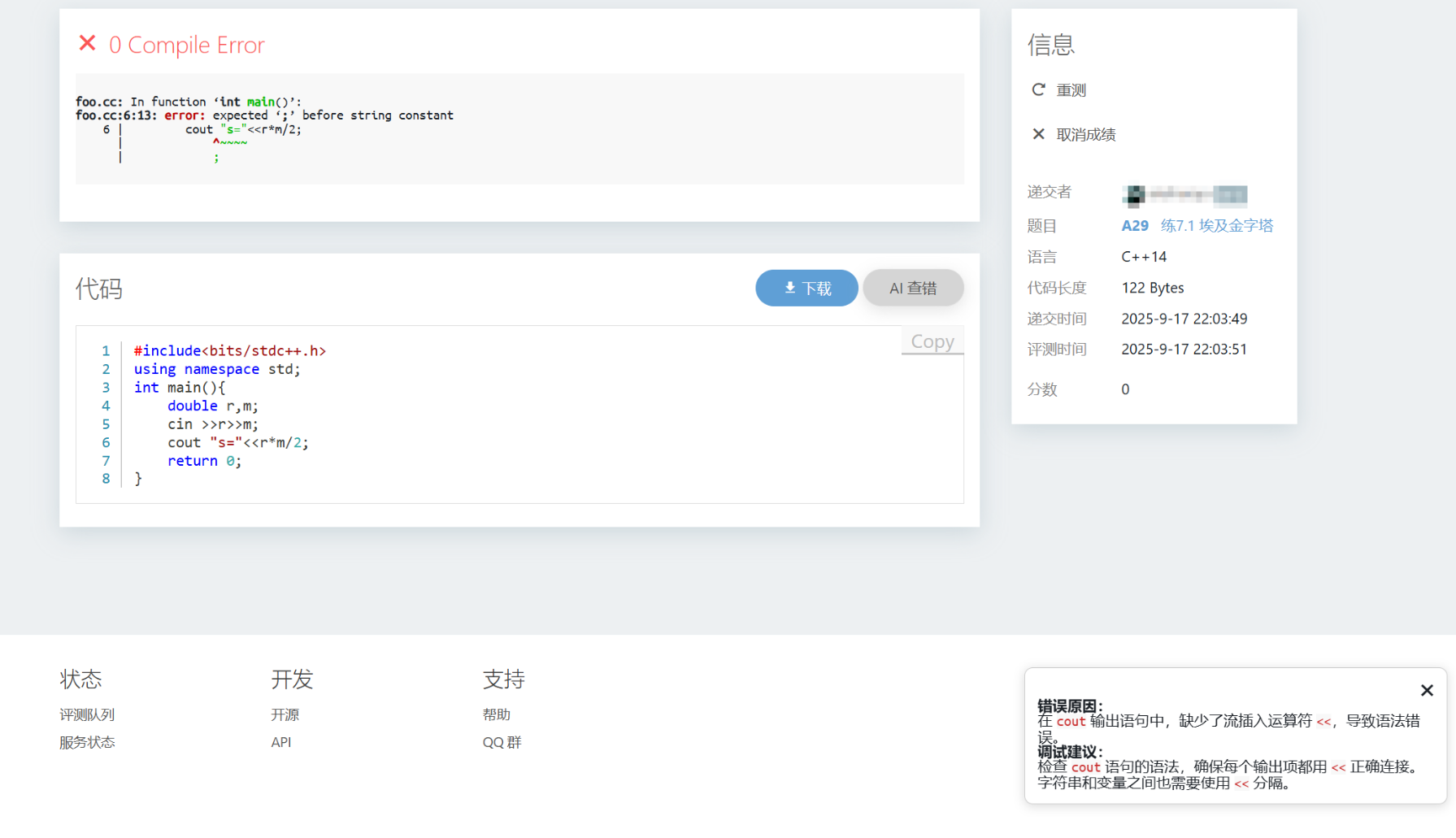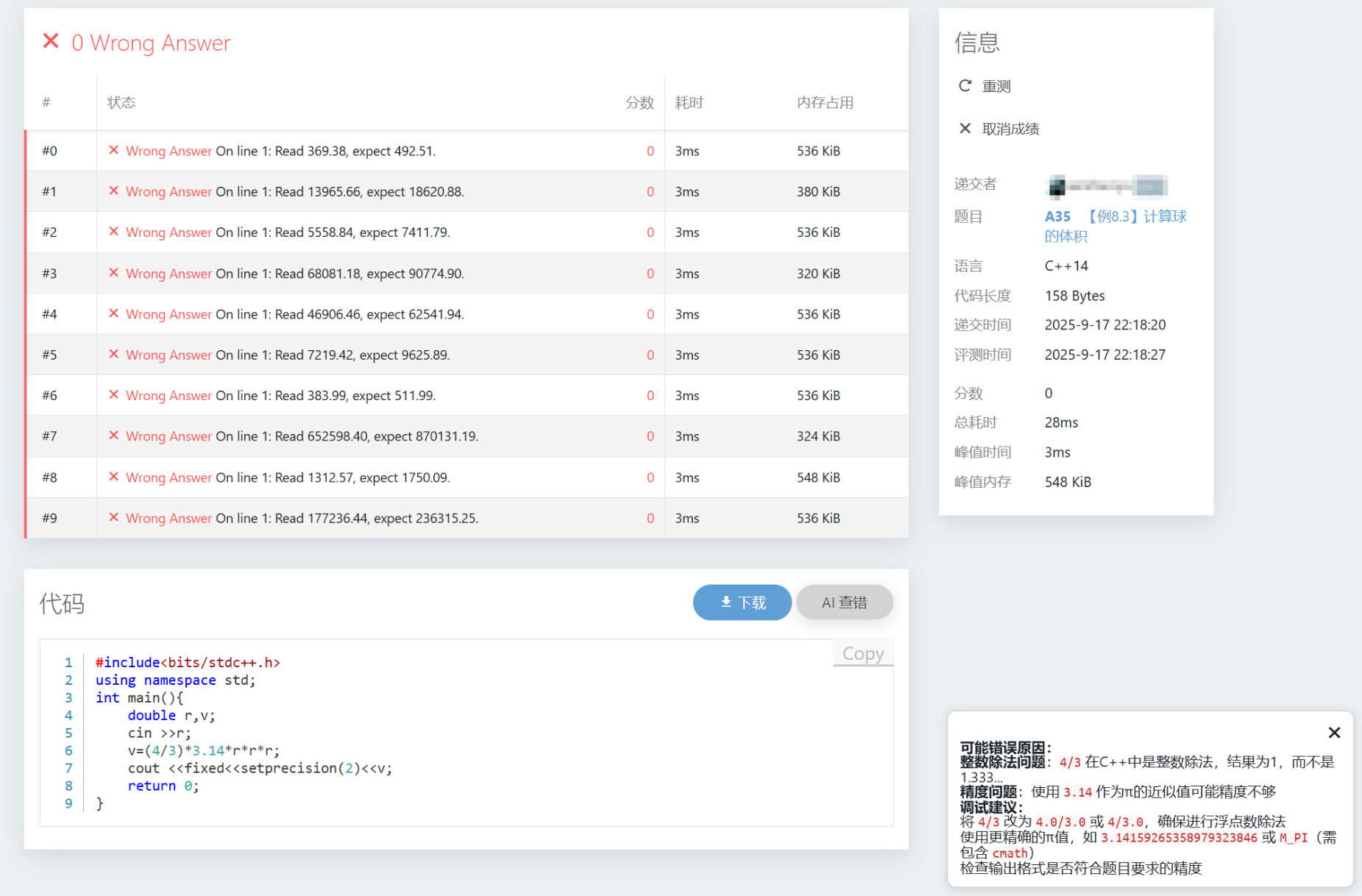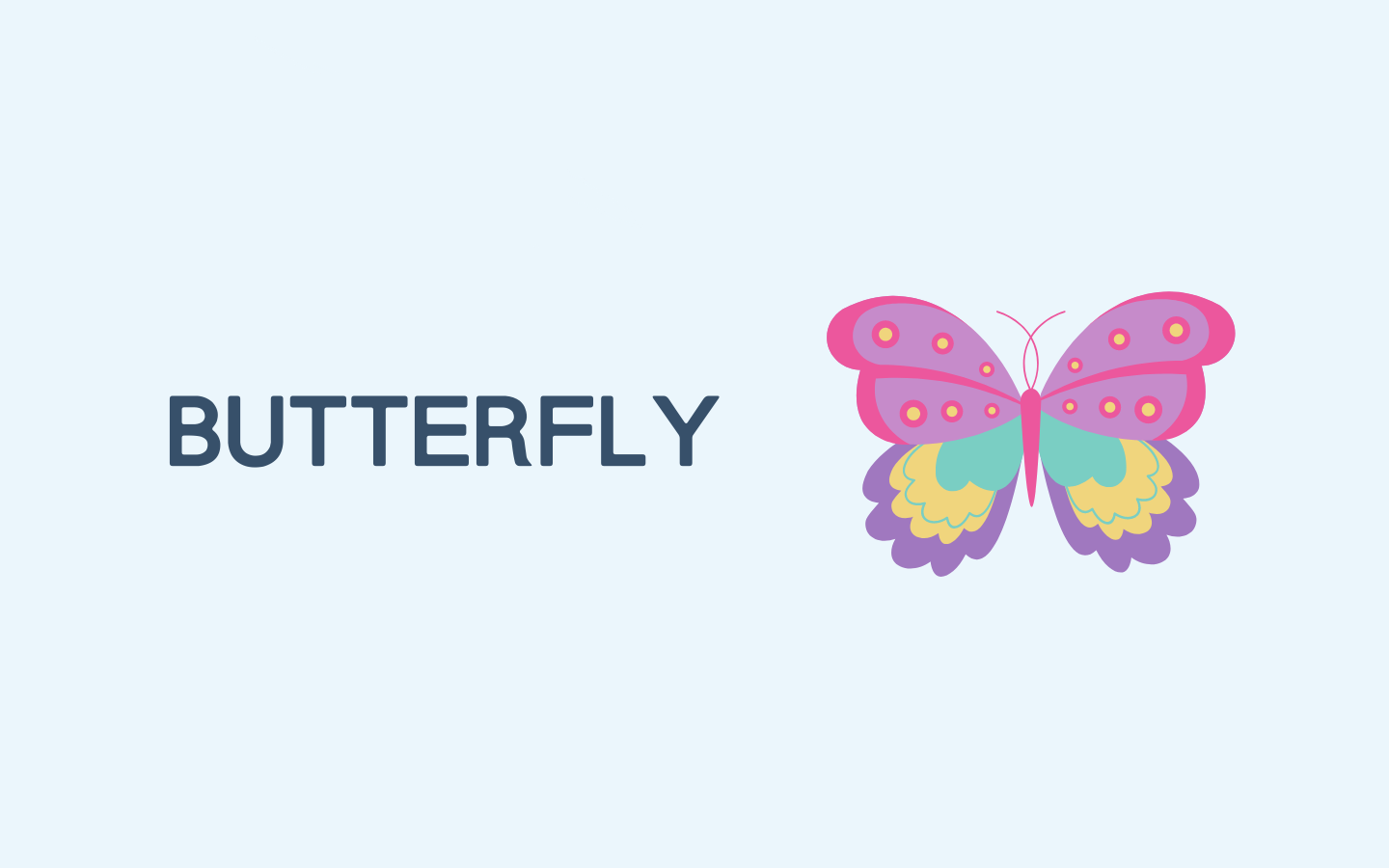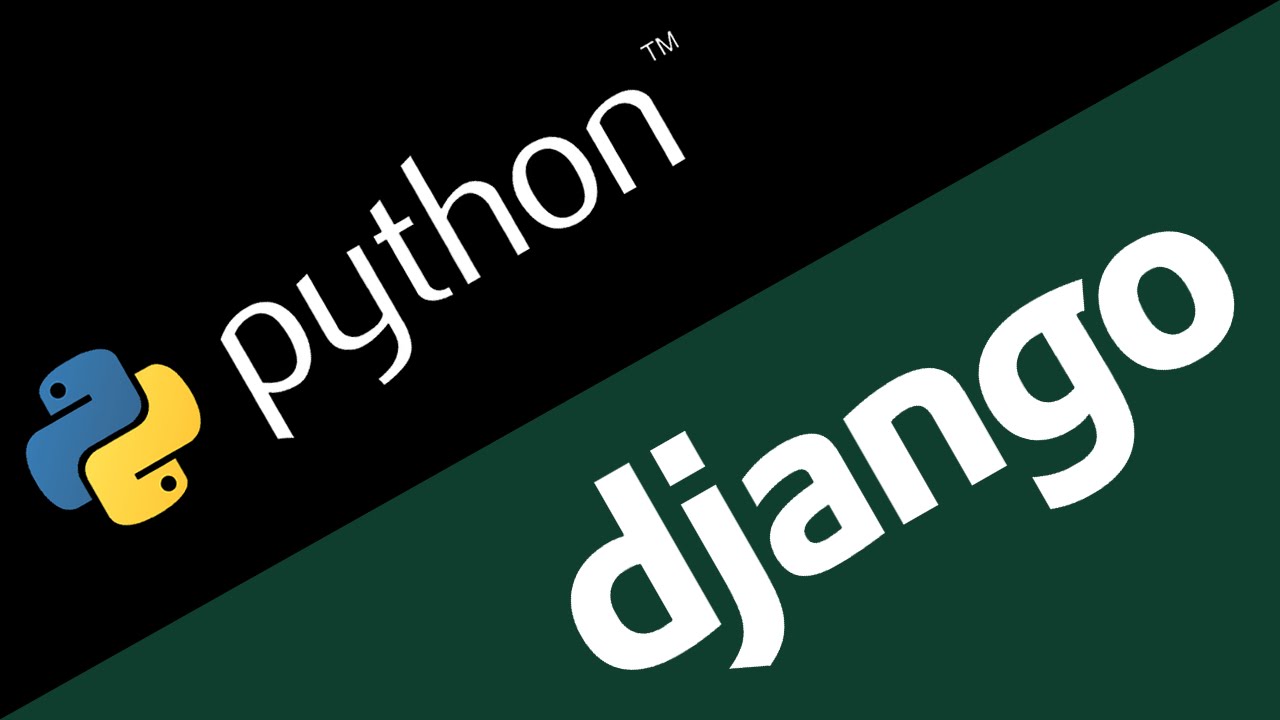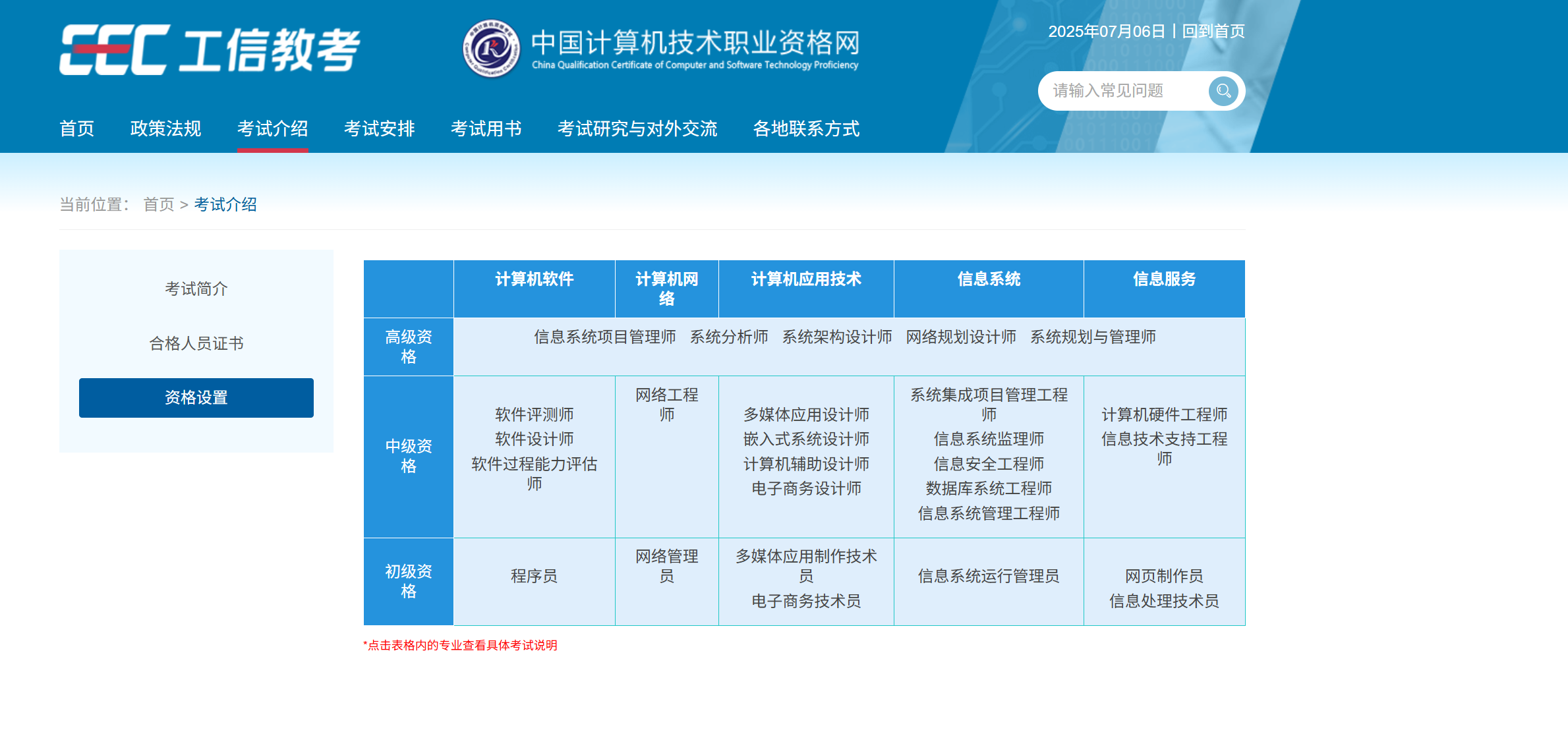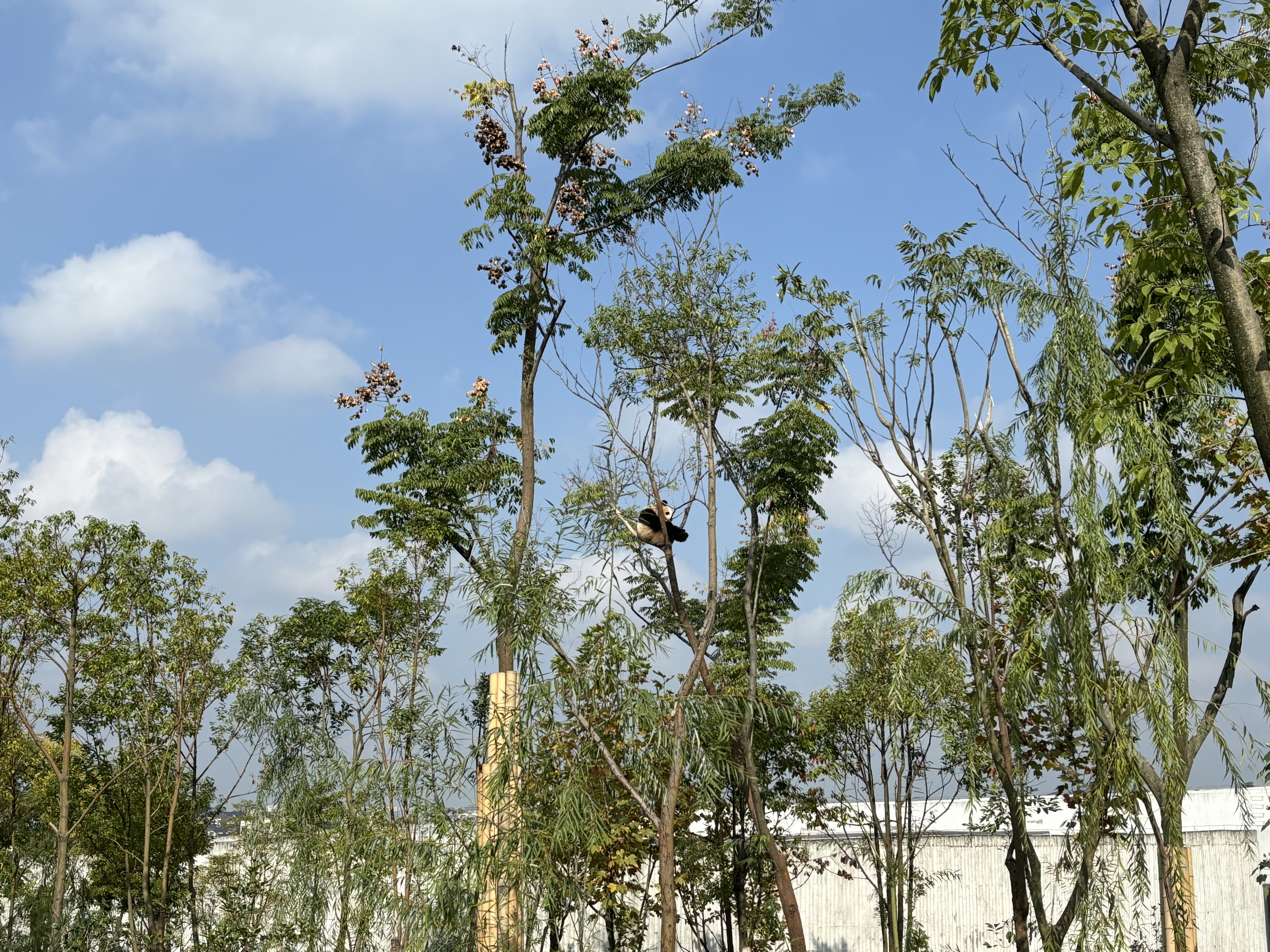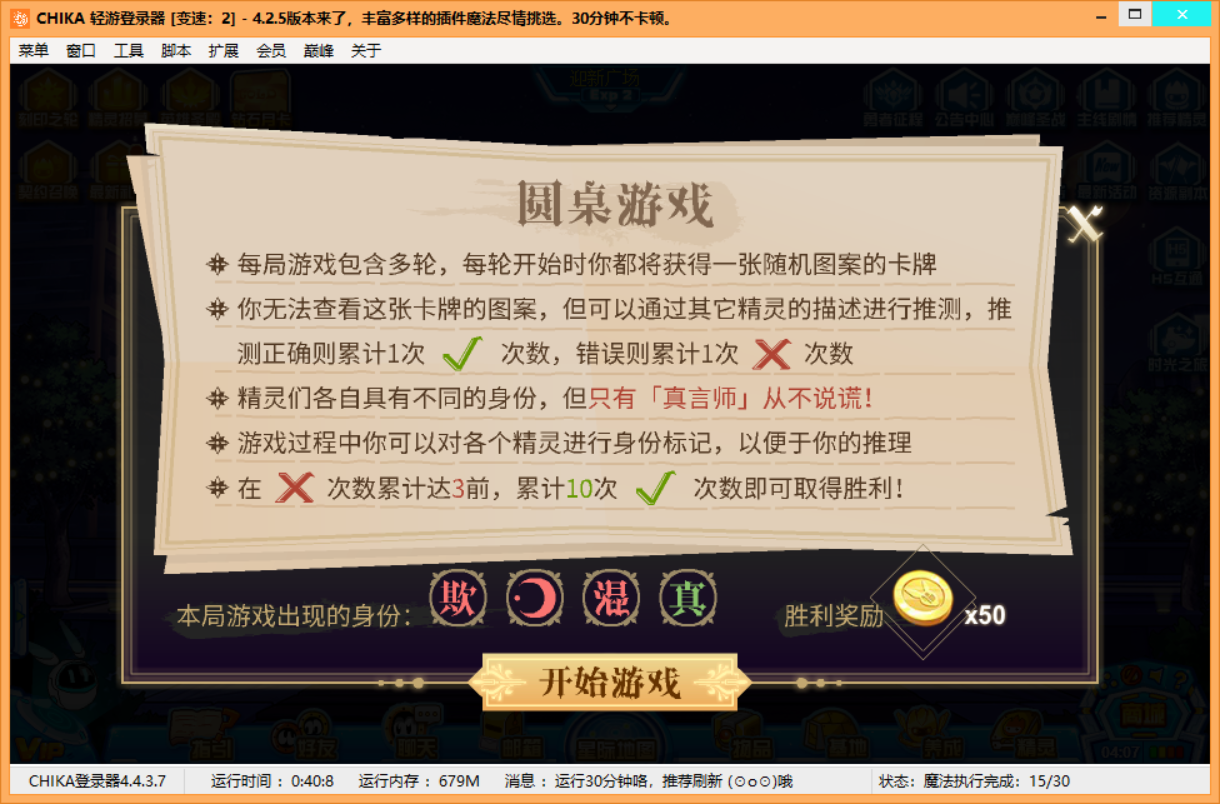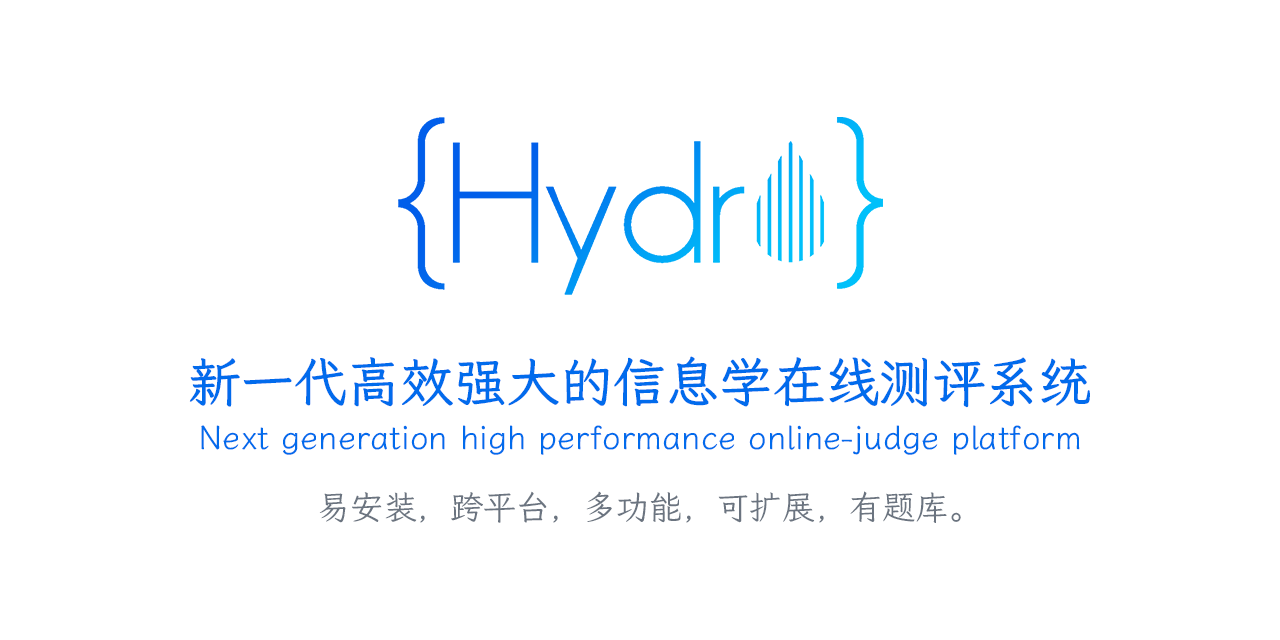前言
我妈正在搞少儿编程教学,基于开源的 Hydrooj 搭了一套 OJ。她很希望能借助大模型的能力辅助孩子们日常的刷题训练,希望我能帮忙集成大模型用于 难题解答 和 代码查错 。我们不妨把这两个场景叫做 AI 助手 和 AI 查错 。
注册插件
起初我对整个项目信心满满,把所有要做的事情全丢给 ChatGPT5 筹备——集成大模型的事情就得交给大模型!
1 2 3 4 5 你好,我接手了一个 OnlineJudge 的二次开发。 OJ 本身基于开源的 hydroOJ 部署,现在我想在里面融入大模型辅助。具体有两个功能: 1. 如果有用户对某道题没有思路,能够在点开一个思路讲解的按钮; 2. 如果有用户提交后发现编译错误、答案错误、超时等,能够在点开一个帮我找错的按钮,注意不要完全告诉他如何修改,重点是给出提示。 我现在已经 ssh 到后端了,请一步一步为我指导。包括功能详细设计、前端设计、后端对接大模型等。
果然 ChatGPT5 条理清晰地为我制定了整个开发计划,甚至提到了很多细节之处:
1 2 3 4 5 6 7 把“克制”和“成本”落到代码上: 1. 禁用范围:检测“比赛/作业进行中”的路由前置拦截,直接返回“当前不可用”。(你可以在插件里读取题目/比赛状态;最简做法:前端比赛页直接不渲染按钮。) 2. 难度阈值 & 尝试次数。例如:用户至少有 1 次提交或在题面停留 ≥ 90 秒才可点“思路讲解”;用户对该题 3 次以上非 AC 才可点“找错”。(阈值存在配置中。) 3. 严格限流(IP + 用户 + 题目)例如:/api/llm/explain 每用户每题每天 2 次;/api/llm/diagnose 每提交 1 次。 4. 响应清洗(去“显式修复”):正则剔除“超过 N 行的代码块”、出现 int main/#include/class Solution 等特征时,提示被收敛;JSON 输出严格校验(Zod),字段超长截断。 5. 缓存。思路讲解按 problemId + titleHash + tagsHash 做缓存(例如 24h),避免同题重复消耗;找错仅缓存“相同提交号”的结果。 6. 多厂商兜底:主路由 429/超时/风控即切备用(Qwen → GLM → Doubao),提升可用性。
我对它生成的步骤信心满满。首先是创建并初始化 hydrooj 的插件:
1 2 3 4 sudo mkdir -p /opt/hydro-plugins/llm-assist && cd /opt/hydro-plugins/llm-assistnpm init -y npm i openai zod hydrooj addon add /opt/hydro-plugins/llm-assist
hydrooj 部署使用 pm2 来管理进程。修改插件代码 index.js 后执行 restart 即可应用;logs 可查看日志。
1 2 pm2 restart hydrooj pm2 logs hydrooj --lines 200
Route 注册问题
我很快卡在了注册路由 阶段。在index.js 里尝试了大模型推荐的各种注册方法都没法生效:
1 2 3 4 5 6 7 8 9 10 11 12 13 14 15 16 17 18 19 20 21 22 23 24 25 26 27 28 29 30 31 32 33 34 35 36 37 38 39 40 41 42 43 44 45 46 47 48 49 50 51 export async function apply (ctx ) { ctx.Route ('GET' , '/api/llm/health' , () => ({ ok : true })); } export async function apply (ctx ) { const router = Router (); router.get ('/llm/health' , (req, res ) => { res.json ({ ok : true }); }); } export async function apply (ctx ) { const router = require ('express' ).Router (); router.get ('/health' , (req, res ) => { res.json ({ ok : true }); }); ctx.useRouter ('/llm-api' , router); } export async function apply (ctx ) { ctx.use ('/api' , router); } module .exports = async function (ctx ) { ctx.route ('get' , '/api/llm/query' , async (req, res) => { const question = req.query .q ; const answer = await callLLM (question); res.body = { success : true , data : answer }; }); module .exports = async function apply (ctx ) { const router = ctx.inject ('router' ); router.get ('/api/llm/test' , async (req, res) => { res.body = { hello : 'world' }; }); }; module .exports = async function apply (ctx ) { const { http } = ctx.scope ; const { router } = http; router.get ('/api/llm/query' , async (req, res) => { res.body = { success : true , data : 'Hello from LLM!' }; }); };
从日志里看,index.js 里成功走到了插件注册函数,但要不注册时报错要不不生效。我偶尔想起时就用类似下面的 prompt 向大模型提问,但一连卡了好几天都没有进展。我按照 ChatGPT5 给出的排查建议,在日志里打印了 ctx 里包含的字段内容,发现键有点少,一度怀疑是 hydrooj 未支持后端路由注册功能。
1 2 3 4 5 6 我在二次开发 hydrooj,在后端后创建了如下文件夹: /opt/hydro-plugins/llm-assist# ls cookie.txt env.sh index.js node_modules package.json package-lock.json 我想在 index.js 里开发个对接 llm 的功能,总体思路是开出一些后端新接口,当前端特定按钮按下后触发这些接口的调用。 我试过很多接口注册方式,例如 ctx.Route('get')、ctx.api.get、ctx.Router().get() 等,但都注册失败了(即用 pm2 restart hydrooj 重启后日志里有报错,且触发 curl 验证时失败),怀疑是 hydrooj 没有暴露这些能力。 请为我找一些 hydrooj 插件的源码(特别是涉及接口注册的),参考他们的方式为我还原一个能注册接口的最小js代码,供我本地验证。
直到我在官网翻到一篇 使用 TypeScript 编写插件 ,里面显式注册了 Route 。我不关心这篇文档里讲的制作剪贴板的细节,立马通知大模型类比这篇文档生成一份最小可运行的 Route 注册代码,果然大获成功:
1 2 3 4 5 6 7 8 9 10 11 12 13 14 15 16 17 18 19 20 21 const { Handler , PRIV } = require ('hydrooj' ); class LlmPromptHandler extends Handler { async get ( this .response .body = { ok : true , path : 'llm-assist/prompt' , method : 'GET' , ts : Date .now () }; } } exports .apply = async function (ctx ) { ctx.Route ('llm_assist_prompt' , '/llm-assist/prompt' , LlmPromptHandler ); };
注意 hydrooj 的所有后端接口都有登录检查,在用 curl 验证接口之前要先模拟前端拿到 cookie。
1 2 curl -c cookie.txt -X POST http://127.0.0.1:8888/login -H "Content-Type: application/x-www-form-urlencoded" -d "uname=xxx&password=xxx" curl -b cookie.txt -X GET http://127.0.0.1:8888/llm-assist/prompt
对接大模型
我选择 qwen3-coder 作为后端对接大模型,在 阿里云百炼平台 生成 API KEY 后就可以交给 ChatGPT5 了:
1 2 3 4 5 6 7 你好,我正在针对开源的 hydro OJ 进行二次开发,现在我想在里面融入大模型辅助。具体来说 1. 如果有用户对某道题没有思路,能够在点开一个思路讲解的按钮; 2. 如果有用户提交后发现编译错误、答案错误、超时等,能够在点开一个帮我找错的按钮,注意不要完全告诉他如何修改,重点是给出提示。 现在我已经在 /opt/hydro-plugins 下创建出 llm-assist 插件并应用此插件。现在请你为我设计详细的功能,并给出前后端的代码实现。 大模型对接 qwen3-coder-plus,我已有 API KEY。 请基于我已测试成功的 route 接口注册代码进行开发: # 此处贴入上一次测试成功的 Route 注册代码
AI 很丝滑地生成了一份辅助代码 llm_client.js,用于 hydrooj 插件和大模型的交互。
1 2 3 4 5 6 7 8 9 10 11 12 13 14 15 16 17 18 19 20 21 22 23 24 25 26 27 28 29 30 31 32 33 34 35 36 37 38 39 40 41 42 43 44 45 46 47 48 49 50 51 52 53 54 55 const fetch = require ('node-fetch' );const MODEL_API_URL = 'https://dashscope.aliyuncs.com/compatible-mode' ;const MODEL_API_KEY = 'sk-xxx' ;const DEFAULT_MODEL = 'qwen3-coder-plus' ;async function callLLM ({ systemPrompt, userPrompt, max_tokens = 1024 , temperature = 0.2 , stream = false } ) { const url = `${MODEL_API_URL.replace(/\/$/, '' )} /v1/chat/completions` ; const body = { model : DEFAULT_MODEL , messages : [ { role : 'system' , content : systemPrompt }, { role : 'user' , content : userPrompt } ], max_tokens, temperature, }; const res = await fetch (url, { method : 'POST' , headers : { 'Content-Type' : 'application/json' , 'Authorization' : `Bearer ${MODEL_API_KEY} ` , }, body : JSON .stringify (body), }); if (!res.ok ) { const txt = await res.text (); throw new Error (`LLM API error ${res.status} : ${txt} ` ); } const data = await res.json (); let content = '' ; try { if (data.choices && data.choices .length > 0 ) { const msg = data.choices [0 ].message || data.choices [0 ].delta || {}; content = msg.content || data.choices [0 ].text || '' ; } else if (data.output && Array .isArray (data.output ) && data.output [0 ]) { content = data.output [0 ].content || '' ; } else { content = JSON .stringify (data); } } catch (e) { content = JSON .stringify (data); } return { raw : data, text : content }; } module .exports = { callLLM };
在插件主逻辑 index.js 里注册两个场景的后端 API 并调用 llm_client.js:
1 2 3 4 5 6 7 8 9 10 11 12 13 14 15 16 17 18 19 20 21 22 23 24 25 26 27 28 29 30 31 32 33 34 35 36 37 38 39 40 41 42 43 44 45 46 47 48 49 50 51 52 53 54 55 56 57 58 59 60 61 62 63 64 65 66 67 68 69 70 71 72 73 74 75 76 77 78 79 80 81 82 83 84 85 86 87 88 89 90 91 const { Handler } = require ('hydrooj' );const path = require ('path' );const fs = require ('fs' ).promises ;const { callLLM } = require ('./llm_client' );function safeTruncate (s, n ) { if (!s) return '' ; if (s.length <= n) return s; return s.slice (0 , n) + '\n\n--- [truncated] ---' ; } const SYSTEM_PROMPT_IDEA = ` 你是一个资深的竞赛编程助手。当用户请求题目的解题思路/提示时,请: - 给出最简明的核心思路,不需要提供代码、具体实现步骤、复杂度分析、测试用例等内容; - 如果有多种方法,简要列出并说明优缺点。 ` ;const SYSTEM_PROMPT_DEBUG = ` 你是一个竞赛编程调试助手。当用户请求“调试提示”时,请: - 阅读题目、用户代码、编译信息、判题结果; - 给出可能的错误原因和检查建议; - 语言简洁,不要提供完整修正后的代码或逐行修改方案; ` ;class LlmPromptHandler extends Handler { async post ( try { const ip = this .request .ip || (this .request .headers && this .request .headers ['x-forwarded-for' ]) || 'anon' ; if (!rateLimit (ip)) { this .response .status = 429 ; this .response .body = { ok : false , error : 'rate_limited' }; return ; } const body = (this .request && this .request .body ) || {}; const type = body.type || 'idea' ; const language = body.language || body.lang || 'C++' ; const problemId = body.problemId || body.pid || null ; const problemTitle = body.title || '' ; const statement = safeTruncate (body.statement || '' , 3000 ); const code = safeTruncate (body.code || '' , 20000 ); const compileOutput = safeTruncate (body.compileOutput || '' , 2000 ); const judgeResult = safeTruncate (body.judgeResult || '' , 1000 ); let userPrompt = '' ; let systemPrompt = SYSTEM_PROMPT_IDEA ; if (type === 'idea' ) { systemPrompt = SYSTEM_PROMPT_IDEA ; userPrompt = `题目 ID: ${problemId || 'N/A' } 题目标题: ${problemTitle} 题目描述: ${statement} 请用中文给出此题最关键的思路/提示 ` ; } else { systemPrompt = SYSTEM_PROMPT_DEBUG ; userPrompt = `题目: ${problemTitle} 语言: ${language} 判题结果: ${judgeResult} 编译输出(如有): ${compileOutput} 用户提交代码(已截断): ${code} 请用中文给出简洁的可能错误原因及调试步骤,不要直接给出完整修正后的代码。` ; } const { text, raw } = await callLLM ({ systemPrompt, userPrompt, max_tokens : 1024 , temperature : 0.15 }); this .response .body = { ok : true , type, text, meta : { truncated_code : code.length >= 20000 }, raw }; } catch (err) { this .response .status = 500 ; this .response .body = { ok : false , error : err.message || String (err) }; } } } exports .apply = async function (ctx ) { ctx.Route ('llm_assist_prompt' , '/llm-assist/prompt' , LlmPromptHandler ); };
重启 hydrooj 后,可用 curl 验证这两个场景的接口注册是否生效、大模型返回是否合理。
1 2 3 4 5 6 7 8 9 10 11 12 13 14 15 16 17 18 19 20 21 22 curl -b cookie.txt \ -H "Content-Type: application/json" \ -X POST http://127.0.0.1:8888/llm-assist/prompt \ -d "{ \"type\": \"idea\", \"problemId\": \"123\", \"title\": \"两数之和\", \"statement\": \"给定一个整数数组 nums 和一个目标值 target,请在数组中找出两个数使它们的和为 target。返回这两个数的索引。\" }" curl -b cookie.txt \ -H "Content-Type: application/json" \ -X POST http://127.0.0.1:8888/llm-assist/prompt \ -d "{ \"type\": \"debug\", \"problemId\": \"123\", \"title\": \"两数之和\", \"language\": \"C++\", \"code\": \"#include <bits/stdc++.h>\nint main(){int n,t;cin>>n>>t;return 0;}\", \"compileOutput\": \"warning: unused variable 'n'\", \"judgeResult\": \"WA on test 5\" }"
ChatGPT5 考虑到了流控,在 index.js 里补了如下代码。我简单设置了 5/min,以后可加个无过期的缓存。
1 2 3 4 5 6 7 8 9 10 11 12 13 const RATE_LIMIT_WINDOW_MS = 1000 * 60 ; const RATE_LIMIT_MAX = parseInt (process.env .LLM_RATE_LIMIT || '5' ); const buckets = new Map ();function rateLimit (ip ) { const now = Date .now (); if (!buckets.has (ip)) buckets.set (ip, []); const arr = buckets.get (ip); while (arr.length && arr[0 ] < now - RATE_LIMIT_WINDOW_MS ) arr.shift (); if (arr.length >= RATE_LIMIT_MAX ) return false ; arr.push (now); return true ; }
前端模板修改
我想在前端引入按钮,相关写法一窍不通,只能求出 ChatGPT5。它建议我创建 static/llm-assist.js 的代码来承载前端组件(会涉及调用后端的逻辑),并将其注册到 index.js 里——这一点看上去很科学。
1 2 3 4 5 6 7 8 9 10 11 12 13 14 15 16 17 class StaticJsHandler extends Handler { async get ( const full = path.join (__dirname, 'static' , 'llm-assist.js' ); try { const data = await fs.readFile (full, 'utf8' ); this .response .type = 'application/javascript' ; this .response .body = data; } catch (e) { this .response .status = 404 ; this .response .body = 'Not found' ; } } } exports .apply = async function (ctx ) { ctx.Route ('llm_assist_static' , '/llm-assist/static/llm-assist.js' , StaticJsHandler ); ... }
那么如何去修改前端的 html 呢?ChatGPT5 建议我在 index.js 里使用 renderHTML。以“AI 助手”场景举例:智能地检测当前的页面是否是题目详情页,如果是的话就动态在 html 里插入 static/llm-assist.js 组件。逻辑是通的,但我反复调试后发现无论在什么页面都没法触发 renderHTML 这个函数,自然没法加载成功。
1 2 3 4 5 6 7 8 9 10 11 12 13 14 15 16 17 18 19 20 21 22 23 exports .apply = async function (ctx ) { ... ctx.on && ctx.on ('renderHTML' , (html, req ) => { try { const isProblemDetail = /<html[^>]*data-page=["']problem_detail["']/i .test (html); if (!isProblemDetail) return html; const injectTag = '<script src="/llm-assist/static/llm-assist.js"></script>' ; if (html.indexOf (injectTag) !== -1 ) return html; if (html.includes ('</body>' )) { return html.replace ('</body>' , `${injectTag} </body>` ); } else { return html + injectTag; } } catch (e) { console .error ('llm-assist: renderHTML inject error' , e); return html; } }); }
ChatGPT5 给出的另一条路子是:hydrooj 已在 templates 目录下定义了各类前端显示的模板文件,将目标页面复制到插件对应的目录下修改,启动时即可智能完成覆盖。我在 hydrooj 的安装目录里找了一圈,愣是没找到对应的 templates 目录,后来发现在官方插件 @hydrooj/ui-default 里有定义,可在 node_modules 里找到。
按照 ChatGPT5 的指示,我找到了题目详情页 ui-default/templates/problem_detail.html,将其复制到插件目录下 llm-assist/templates/problem_detail.html,里面插入一段加载 llm-assist.js 的 script。经过反复尝试,这种修改并不会生效。我一度怀疑是加载顺序的问题(ui-default 后于本插件加载导致反向覆盖),但给 index.js 的 package.json 加上依赖插件或修改优先级后,加载失败的问题依然没有解决。
走投无路下我只能尝试最土的方法:直接在 ui-default 的路径下修改模板文件。这种方式被证明是有效的。
AI 助手功能
我需要在题目详情页 problem_detail.html 里集成 AI 助手 按钮。这个 html 里有很多间接引用:
1 2 3 <div class ="medium-3 columns" > <div data-sticky ="large" > {% include "partials/problem_sidebar.html" %} </div > </div >
看起来应该在侧边栏 partial/problem_sidebar.html 里插入这个按钮,它里面又引用了其他模板:
1 2 3 4 5 6 7 8 9 10 11 12 13 14 15 {% if not owner_udoc %} {% set owner_udoc = udoc %} {% endif %} {% if tdoc %} {% if tdoc.rule == 'homework' %} {% include "partials/problem_sidebar_homework.html" %} {% include "partials/homework_sidebar.html" %} {% else %} {% include "partials/problem_sidebar_contest.html" %} {% include "partials/contest_sidebar.html" %} {% endif %} {% else %} {% include "partials/problem_sidebar_normal.html" %} {% endif %}
叶子模块是 partial/problem_sidebar_normal.html,在这里会根据权限的不同展示各种按钮。
正好有一块代码在判断当前是否是 problem_detail 页面,结尾处插入名为 llm-assist-btn 的按钮。
在文件末尾根据是否是 problem_detail 页面动态加载插件里的 static/llm-assist.js 组件。
1 2 3 4 5 6 7 8 9 10 11 12 13 14 15 16 17 18 19 20 21 22 {% if page_name == 'problem_detail' %} <li class ="menu__seperator nojs--hide" ></li> {% if handler.user .own (pdoc) or handler.user .hasPriv (PRIV .PRIV_READ_PROBLEM_DATA ) or handler.user .hasPerm (perm.PERM_READ_PROBLEM_DATA ) %} <li class ="menu__item nojs--hide" ><a class ="menu__link" href ="javascript:;" name ="problem-sidebar__download" > <span class ="icon icon-download" > </span > {{ _('Download') }} </a > </li> {% endif %} {% if handler.user .hasPriv (PRIV .PRIV_USER_PROFILE ) %} <li class ="menu__item nojs--hide" ><a class ="menu__link" href ="javascript:;" name ="problem-sidebar__copy" > <span class ="icon icon-copy" > </span > {{ _('Copy') }} </a > </li> {% endif %} <li class ="menu__item nojs--hide" > <a class ="menu__link" href ="javascript:;" id ="llm-assist-btn" > <span class ="icon icon-robot" > </span > AI 助手 </a > </li> {% endif %} ... {% if page_name == 'problem_detail' %} <script src="/llm-assist/static/llm-assist.js" ></script> {% endif %}
最后就是在插件的 static/llm-assist.js 里定义按钮点击事件,调用后端接口并显示结果。为了不影响 html 整体布局,我要求 ChatGPT5 手动绘制一个能承载结果的悬浮窗(参数细节完全没管,车轱辘能跑起来就行)。
1 2 3 4 5 6 7 8 9 10 11 12 13 14 15 16 17 18 19 20 21 22 23 24 25 26 27 28 29 30 31 32 33 34 35 36 37 38 39 40 41 42 function createResultContainer ( let container = document .getElementById ('llm-assist-result-container' ); if (!container) { container = document .createElement ('div' ); container.id = 'llm-assist-result-container' ; container.style .position = 'fixed' ; container.style .right = '20px' ; container.style .bottom = '80px' ; container.style .width = '400px' ; container.style .maxHeight = '60vh' ; container.style .overflowY = 'auto' ; container.style .background = 'white' ; container.style .border = '1px solid #ccc' ; container.style .borderRadius = '8px' ; container.style .padding = '12px' ; container.style .boxShadow = '0 2px 10px rgba(0,0,0,0.15)' ; container.style .zIndex = '9999' ; container.style .fontSize = '14px' ; const closeBtn = document .createElement ('button' ); closeBtn.innerText = '✖' ; closeBtn.style .float = 'right' ; closeBtn.style .border = 'none' ; closeBtn.style .background = 'transparent' ; closeBtn.style .cursor = 'pointer' ; closeBtn.style .fontSize = '16px' ; closeBtn.addEventListener ('click' , () => { container.style .display = 'none' ; }); container.appendChild (closeBtn); const content = document .createElement ('div' ); content.id = 'llm-assist-result' ; content.style .clear = 'both' ; container.appendChild (content); document .body .appendChild (container); } return container; }
static/llm-assist.js 里还有两个细节要处理:
如何拿到题目的文本内容:我在前端 F12 抓取了一段具体的元素丢给 ChatGPT5,得到一个很高级的函数。
如何把大模型的返回 markdown 格式渲染出来:ChatGPT5 建议我引入 marked,无脑贴上就有效果了。
1 2 3 4 5 6 7 8 9 10 11 12 13 14 15 16 if (!window .marked ) { const script = document .createElement ('script' ); script.src = 'https://cdn.jsdelivr.net/npm/marked/marked.min.js' ; script.onload = () => console .log ('marked.js loaded' ); document .head .appendChild (script); } function getFullProblemText ( const container = document .querySelector ( '.problem-content .section__body.typo.richmedia[data-fragment-id="problem-description"]' ); if (!container) return '' ; return container.innerText .trim (); }
最终的按钮点击的事件注册代码如下:
1 2 3 4 5 6 7 8 9 10 11 12 13 14 15 16 17 18 19 20 21 22 23 24 25 26 27 28 29 30 31 32 33 34 35 36 37 38 document .getElementById ('llm-assist-btn' )?.addEventListener ('click' , async () => { const container = createResultContainer (); const contentDiv = document .getElementById ('llm-assist-result' ); contentDiv.innerHTML = '正在获取题目内容...' ; container.style .display = 'block' ; const problemText = getFullProblemText (); if (!problemText) { contentDiv.innerText = '无法抓取题目内容' ; return ; } contentDiv.innerText = '发送给 AI,等待回答...' ; try { const res = await fetch ('/llm-assist/prompt' , { method : 'POST' , headers : { 'Content-Type' : 'application/json' }, body : JSON .stringify ({ type : 'idea' , problemId : UiContextNew .problemId , title : document .querySelector ('.section__title' )?.innerText || '' , statement : problemText }) }); const data = await res.json (); if (data.ok && data.text ) { contentDiv.innerHTML = window .marked ? marked.parse (data.text ) : data.text ; } else { contentDiv.innerText = data.error || '暂无结果' ; } } catch (err) { console .error (err); contentDiv.innerText = '请求失败,请检查网络或后端接口' ; } });
效果图如下:
AI 查错功能
有个上一个功能做铺垫,我顺藤摸瓜找到了 ui-default 插件下的 templates/record_detail.html。hydrooj 在提交记录的代码展示右上角有一个下载按钮,我正好并排加入一个 AI 查错 按钮。这次需要收集题目详情、代码、编程语言、测评结果、编译错误等数据,ChatGPT5 建议我用 window.LLM_ASSIST_CONTEXT 收集,而非像上一个功能一样在 llm-assist.js 里用 document.querySelector(...) 去抓取。它解释说,提交语言、判题状态这类信息在 JS 里并没有全局变量暴露出来,但可以趁渲染模板时在 rdoc 和 model.problems[...] 拿到。有个细节是,如果测评结果是 Accepted 可以不展示按钮,我用 if rdoc.status != 1 去判断。
1 2 3 4 5 6 7 8 9 10 11 12 13 14 15 16 17 18 19 20 21 22 23 24 25 26 27 28 29 30 31 32 33 {% if rdoc['code' ] or rdoc.files .code %} <div class ="section" > <div class ="section__header" > <h1 class ="section__title" > {{ _('Code') }}</h1 > <div class ="section__tools" > <a class ="primary rounded button" href ="?download=true" > <span class ="icon icon-download" > </span > {% if rdoc.files.hack %}{{ _('Download Hack Input') }}{% else %}{{ _('Download') }}{% endif %} </a > {% if rdoc.status != 1 %} <button class ="secondary rounded button" id ="llm-debug-btn" > <span class ="icon icon-bug" > </span > {{ _('AI 查错') }} </button > {% endif %} </div > <script src ="/llm-assist/static/llm-assist.js" > </script > <script > window.LLM_ASSIST_CONTEXT = { type: 'debug', problemId: ' {{ rdoc.pid }} ', title: ' {{ model.problems [rdoc.pid].title|escape }} ', language: ' {{ model.setting.langs [rdoc.lang].display }} ', code: {{ rdoc.code | dump | safe }} , judgeResult: {{ model.builtin.STATUS_TEXTS [rdoc.status] | default('Unknown' ) | dump | safe }} , compileOutput: {{ rdoc.compilerTexts | join('\n' ) | default('' , true ) | dump | safe }} }; </script > </div > <div class ="section__body" > <pre class ="line-numbers" > <code class ="language-{{ model.setting.langs[rdoc.lang].highlight }}" > {{ rdoc['code'] }}</code > </pre > </div > </div> {% endif %}
我想用 window.LLM_ASSIST_CONTEXT 一并收取题目详情,调试了一下没找到这个文本内容。质问 ChatGPT5 后它怂了,给我换了一种更稳妥的方式:在后端额外调用一次查询题目详情接口。
1 2 3 4 5 6 7 async function fetchProblemStatement (pid ) { const res = await fetch (`/p/${pid} ` ); const html = await res.text (); const tmp = document .createElement ('div' ); tmp.innerHTML = html; return tmp.querySelector ('.problem-content .section__body' )?.innerText || '' ; }
结果的悬浮框我们可以服用上一个功能的 llm-assist-result 组件,那就只剩下按钮的事件定义了:
1 2 3 4 5 6 7 8 9 10 11 12 13 14 15 16 17 18 19 20 21 22 23 24 25 26 27 28 29 30 31 32 33 34 35 36 document .getElementById ('llm-debug-btn' )?.addEventListener ('click' , async () => { const ctx = window .LLM_ASSIST_CONTEXT || {}; const container = createResultContainer (); const contentDiv = document .getElementById ('llm-assist-result' ); container.style .display = 'block' ; contentDiv.innerText = '正在分析错误原因...' ; const statement = await fetchProblemStatement (ctx.problemId ); try { const res = await fetch ('/llm-assist/prompt' , { method : 'POST' , headers : { 'Content-Type' : 'application/json' }, body : JSON .stringify ({ type : 'debug' , problemId : ctx.problemId , title : ctx.title , statement, language : ctx.language , code : ctx.code , judgeResult : ctx.judgeResult , compileOutput : ctx.compileOutput }) }); const data = await res.json (); if (data.ok && data.text ) { contentDiv.innerHTML = window .marked ? marked.parse (data.text ) : data.text ; } else { contentDiv.innerText = data.error || '暂无结果' ; } } catch (err) { console .error (err); contentDiv.innerText = '请求失败,请检查网络或后端接口' ; } });
效果图如下:
